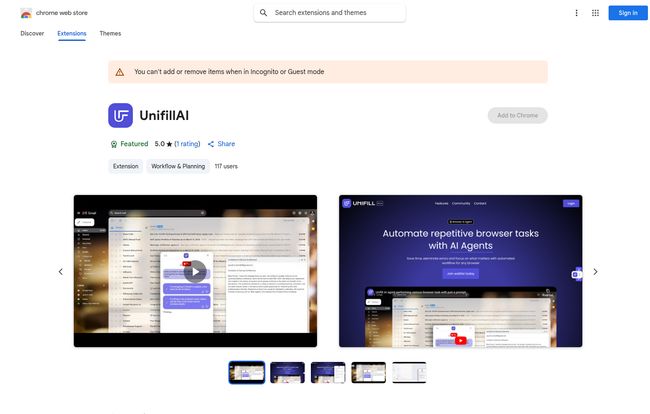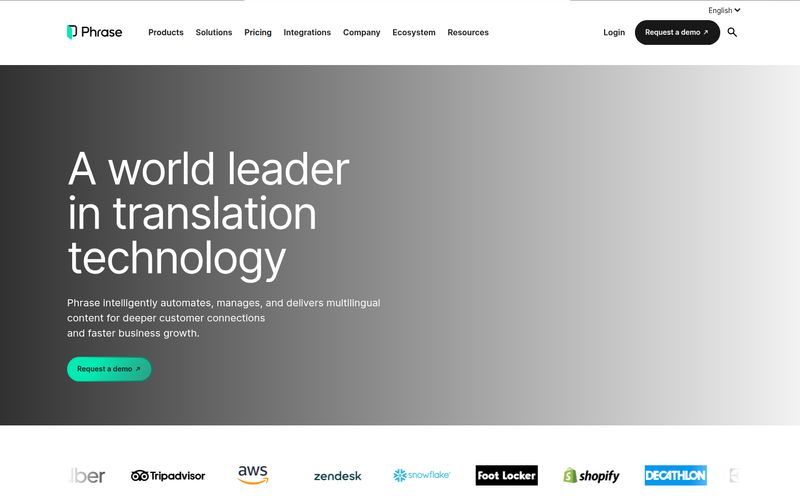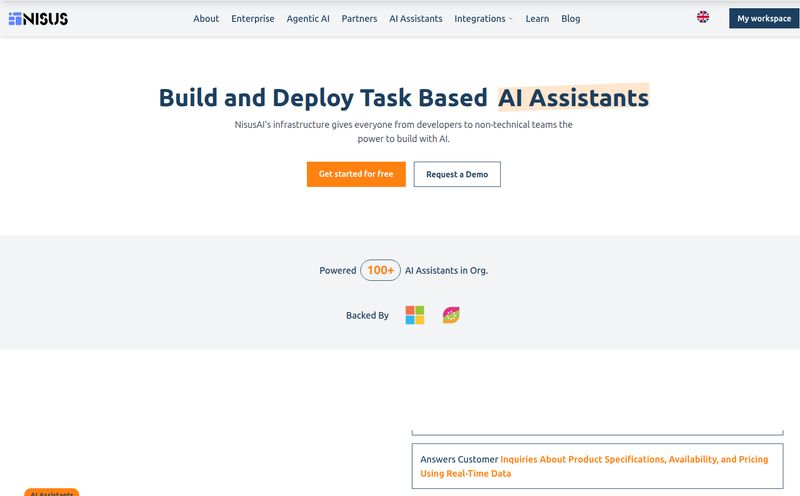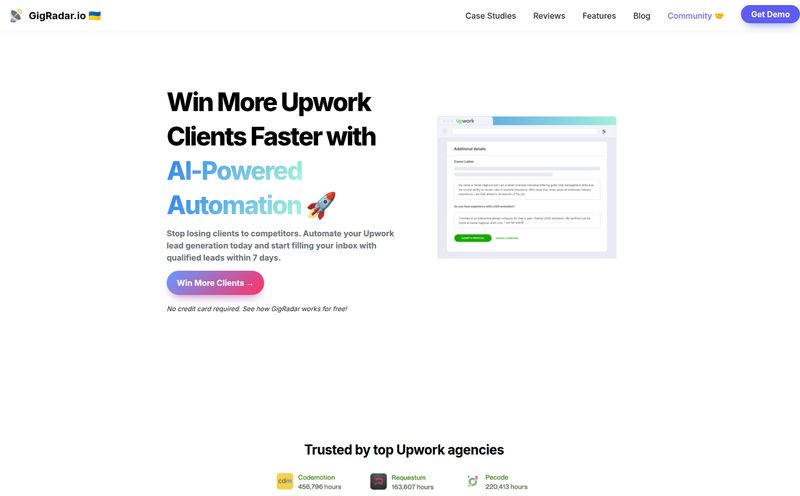Browser automation. It’s one of those phrases that either makes you giddy with excitement or gives you flashbacks to clunky, soul-crushing software from 2005. I’ve been in both camps. For years, the promise of a tool that could just handle the repetitive junk for me felt like a mirage in the digital desert. You know the drill: copying data from a spreadsheet to a web form, filling out lead-gen forms, scraping basic info… it's the stuff that slowly chips away at your soul.
Then, every now and then, a tool pops up on my radar that makes me lean in a little closer. This week, it was a Chrome extension called UniFill AI. It landed with a simple, bold promise: automate any repetitive task on any website using plain English. No code. No complex setup. Just tell it what to do.
Yeah, right. If I had a nickel for every time I've heard that... But, as a professional tinkerer and someone who lives and breathes traffic and efficiency, I had to take it for a spin. Is this another piece of overhyped vaporware, or could it actually be the helpful little browser intern we’ve all been waiting for?
What Exactly is UniFill AI? (And Why Should You Care?)
Let's get the jargon out of the way first. UniFill AI isn't just another form filler like your browser’s built-in autofill. That’s like comparing a calculator to a supercomputer. At its heart, UniFill is an AI Agent that lives inside a browser extension. Think of it less like a rigid program and more like a trainee you've hired to handle your web tasks. You don’t give it a list of complex commands; you just… talk to it.
It uses Natural Language Processing (NLP) to understand what you want. So instead of recording a macro where you have to click pixel-perfect spots, you can theoretically just type, “Hey, go to this list of websites, find the contact email, and put it in this spreadsheet.” The magic here is its claim to work without needing to plug into a website's backend API. This is a big deal. APIs can change or be restrictive. UniFill AI aims to just look at the webpage and understand it, much like a person would. That makes it incredibly flexible, in theory.
For anyone in SEO, sales, marketing, or research, the implications are pretty obvious. Less time on grunt work, more time on strategy. What's not to love?
Putting It to the Test: My First Impressions
Getting started was simple enough. I headed over to the Chrome Web Store, found UniFill AI, and clicked 'Add to Chrome'. Standard procedure. The icon popped up in my extension bar, and that was that. No lengthy onboarding, no 20-step setup wizard. A good start.
The real test is using it. I navigated to a standard contact form on a test site. Clicking the extension icon brings up the interface, which looks clean and, frankly, a bit sparse. It's essentially a command box. This is where you tell the AI what to do.

Visit UniFill AI
I started with something basic: "Fill in the first name with 'John' and the last name with 'Doe'." It worked. The fields populated correctly. Okay, cool, but my browser can do that. So I tried something a little more complex, a workflow. I wanted it to go to a mock e-commerce product page, add the item to the cart, and proceed to checkout. Building these little recipes, or 'workflows', is the core of its power. It’s a bit of a back-and-forth, refining your commands until the AI gets it just right. It feels less like programming and more like teaching someone a new task. There's a slight learning curve, but it's not a technical one; it's a communication one.
The Core Features That Actually Matter
After playing around with it for a while, a few things really stood out to me as being the main selling points.
Smart Automation Across Any Site
The biggest win here is the versatility. Because it's not tied to a specific platform like Shopify or Salesforce, it can adapt. I could see this being used for everything from managing customer support tickets in a custom CRM to applying for jobs on multiple portals, or even just pulling pricing data from a dozen competitors. The fact that it works on the 'front end' of a site makes it almost universally applicable.
"Just Tell Me What to Do": The Magic of Natural Language
This is the make-or-break feature. The whole value proposition hinges on the NLP being good enough. This reminds me of the old days of trying to script iMacros for Firefox... what a nightmare that was. We've come a long way. Being able to type, "Scrape the titles of all the blog posts on this page" instead of wrestling with XPath selectors is a genuine quality-of-life improvement. It lowers the bar for entry, which is fantastic. You don’t have to think like a computer to get the computer to do what you want.
Building Workflows Without Writing a Single Line of Code
This is where it gets powerful for teams. A marketing manager could create a workflow for their team to standardize how they gather lead information. A researcher could build a workflow to extract data from academic journals. It democratizes automation. The people who actually do the repetitive work can now automate it themselves, without needing to file a ticket with the IT department and wait six weeks.
So, Who Is This Tool Really For?
I can see a few key people getting a ton of value out of UniFill AI:
- Sales and Lead Gen Teams: Automating the process of filling out prospect information into a CRM or spreadsheet from LinkedIn or company websites. A massive time-saver.
- SEO and Content Specialists: Quickly pulling SERP data, checking for broken links across a site, or scraping titles and meta descriptions for analysis.
- Small Business Owners: Juggling everything from invoicing to customer outreach? A tool like this could automate chunks of your administrative load.
- Job Seekers: Imagine creating a workflow that auto-fills your information into dozens of job applications on different platforms. That alone is worth its weight in gold.
The Good, The Bad, and The AI
Alright, let's get down to it. No tool is perfect. After the initial excitement, you start to see the rough edges. Here’s my balanced take.
The Good Stuff (The Wins)
Time-saving is the obvious one. The potential to claw back hours spent on mind-numbing tasks is immense. It's also super easy to get started with, and the no-code approach is genuinely refreshing. For straightforward, repetitive tasks, it feels like a glimpse into the future of work. It reduces the chance of manual data entry errors—copy-paste mistakes are more common than we admit.
The Not-So-Good Stuff (The Reality Check)
First, it's still a browser extension, which means you're tied to having that browser open and running. This isn't a cloud-based server doing your work while you sleep. Second, the biggest challenge for any tool like this is the reliability of its AI. What happens when a website redesigns its form and the AI gets confused? It’s like telling an intern to 'get the reports' and they come back with a stapler because the filing cabinet moved. You'll need to supervise it, especially at first. There will be times it just doesn’t understand your command, and you'll have to rephrase it. Lastly, the info on the store page hints that premium features might require a subscription. Which brings us to...
Let's Talk Money: The UniFill AI Pricing Mystery
As of this writing, there's no clear pricing page. The Chrome Store page mentions potential in-app purchases. This is pretty common for new tools or those with an enterprise-focused model. They're likely testing the waters, maybe operating on a freemium model where basic use is free but creating complex, multi-step workflows or running a high volume of tasks will cost you.
My guess? We'll see a tiered system: a free version for casual users, and paid monthly plans for professionals and teams. I'll be keeping an eye on this, because price is a massive factor in whether a tool goes from a 'cool toy' to an 'essential part of my stack'.
How UniFill AI Stacks Up Against the Competition
UniFill AI is carving out an interesting middle ground. It's not trying to be a full-blown, enterprise-grade RPA (Robotic Process Automation) suite like UiPath or Automation Anywhere. Those tools are incredibly powerful but also complex and expensive. On the other end, you have simple macro recorders that are often brittle and frustrating.
UniFill AI seems to be aiming for the 'prosumer' – the professional who needs more power than a simple autofill but doesn't have the time or budget for a massive RPA platform. Its use of natural language is its main differentiator against most other browser automation tools, which often require a more visual, drag-and-drop interface that can still feel a bit like coding.
Frequently Asked Questions about UniFill AI
Is UniFill AI safe to use with my personal data?
According to their privacy disclosure on the Chrome Web Store, they handle personally identifiable information and website content. They state that your data is not sold to third parties and is not used for purposes unrelated to the item's core functionality. As with any extension that interacts with webpages, it's wise to be cautious and use it on sites you trust.
Do I need to be a developer or coder to use it?
Absolutely not. That’s the entire point. The tool is built around natural language commands, meaning you just type what you want it to do in plain English. This makes it accessible to everyone, regardless of technical skill.
What kind of tasks can UniFill AI actually automate?
The list is long! Think data entry, filling out contact or checkout forms, scraping data like names, emails, or prices from web pages, testing websites, and consolidating information from multiple tabs into one place. If it's a repetitive task you do in a browser, there's a good chance UniFill can handle it.
Is UniFill AI completely free?
Currently, it seems to be free to install and use, but the developer notes there may be in-app purchases. This suggests a freemium model is likely, where advanced features or higher usage limits might require a paid subscription in the future.
Will it work on literally any website?
In theory, yes. Because it 'reads' the page like a human, it's not dependent on a specific site's structure. However, very complex or unusually coded websites (especially those with heavy dynamic JavaScript) might pose a challenge. You may need to refine your commands for certain sites.
Is UniFill AI Your Next Productivity Hack? My Final Thoughts
So, what’s the verdict? I came in skeptical, and I’m walking away... cautiously optimistic. UniFill AI isn't magic. It's a tool, and like any tool, it requires a bit of learning and supervision. The AI can and will misunderstand you sometimes.
But when it works, it feels like a superpower. It successfully bridges the gap between simple, dumb autofill and overly complex RPA software. It puts the power of automation into the hands of the people who need it most, without forcing them to learn a new programming language. For any marketer, salesperson, or researcher who feels like they're drowning in digital paperwork, UniFill AI is absolutely worth installing. It might just be the helpful, tireless intern you've always wanted for your browser. Just be prepared to teach it the ropes.



